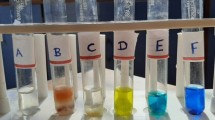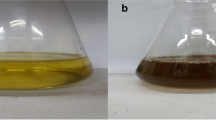Abstract
Nowadays, there are some inconsistent reports on antibacterial and other biological properties of honey. It seems that, depending on the type, geographical location and source of flowers, honey may or may not have antibacterial, anticancer, and wound healing properties. This natural product has a high potential to combat a variety of diseases, especially infectious diseases, however, directly using this substance in therapeutic processes faces some limitations. The aim of this study is to investigate the cytotoxicity and antibacterial behaviors of Astragalus gossypinus honey. Moreover, the potential of this honey, as an interface of natural products and nanobiotechnology, in the green synthesis of silver nanoparticles was investigated and the antibacterial and cytotoxicity properties of nanoparticles were also assessed. Based on the results, the honey does not show significant antibacterial and cytotoxic activity by itself, while it plays an efficient role in the synthesis and functionalization of stable silver nanoparticles (spherical, 42.7 nm). The honey-functionalized nanoparticles show an ambivalent cytotoxic effect against the L-929 cell line. So that they stimulate the viability of the cells at low concentrations, while they show toxicity toward them at concentrations above 50 μg/mL. The nanoparticles also have a good dose-dependent antibacterial activity against E. coli, P. aeruginosa, and S. aureus bacterial strains.







Similar content being viewed by others
References
Dezmirean, G. I., Mărghitaş, L. A., Bobis, O., Dezmirean, D. S., Bonta, V., & Erler, S. (2012). Botanical origin causes changes in nutritional pro fi le and antioxidant activity of fermented products obtained from honey. Journal of Agricultural and Food Chemistry, 60, 8028–8035.
Bíliková, K., & Šimúth, J. (2010). New criterion for evaluation of honey: quantification of royal jelly protein apalbumin 1 in honey by ELISA. Journal of Agricultural and Food Chemistry, 58, 8776–8781. https://doi.org/10.1021/jf101583s.
White, J. W. (1957). The composition of honey. Bee World, 38, 57–66. https://doi.org/10.1080/0005772X.1957.11094976.
Molan, P. C. (1992). The antibacterial activity of honey: 1. The nature of the antibacterial activity. Bee World, 73, 5–28.
Schramm, D. D., Schramm, D. D., Karin, M., Karin, M., Schrader, H. R., Schrader, H. R., Holt, R. R., Holt, R. R., Cardetti, M., Cardetti, M., Keen, C. L., & Keen, C. L. (2003). Honey with high levels of antioxidants can provide protection to healthy human subjects. Journal of Agricultural and Food Chemistry, 12, 1732–1735.
Wang, Q., Cai, W. J., Yu, L., Ding, J., & Feng, Y. Q. (2017). Comprehensive profiling of phytohormones in honey by sequential liquid-liquid extraction coupled with liquid chromatography-mass spectrometry. Journal of Agricultural and Food Chemistry, 65, 575–585. https://doi.org/10.1021/acs.jafc.6b04234.
Kato, Y., Umeda, N., Maeda, A., Matsumoto, D., Kitamoto, N., & Kikuzaki, H. (2012). Identification of a novel glycoside, leptosin, as a chemical marker of manuka honey. Journal of Agricultural and Food Chemistry, 60, 3418–3423. https://doi.org/10.1021/jf300068w.
Heidari, T., Roozbahani, N., Amiri Farahani, L., Attarha, M., Akbari Torkestani, N., Jamilian, M., & Bekhradi, R. (2013). Does Iranian Astragalus gossypinus honey assist in healing caesarean wounds and scars? European Journal of Internal Medicine, 5, 226–233. https://doi.org/10.1016/j.eujim.2013.01.005.
Dhand, V., Soumya, L., Bharadwaj, S., Chakra, S., Bhatt, D., & Sreedhar, B. (2016). Green synthesis of silver nanoparticles using Coffea arabica seed extract and its antibacterial activity. Materials Science and Engineering: C, 58, 36–43. https://doi.org/10.1016/j.msec.2015.08.018.
Rizzello, L., & Pompa, P. P. (2014). Nanosilver-based antibacterial drugs and devices: mechanisms, methodological drawbacks, and guidelines. Chemical Society Reviews, 43, 1501–1518. https://doi.org/10.1039/c3cs60218d.
Prabhu, S., & Poulose, E. K. (2012). Silver nanoparticles: mechanism of antimicrobial action, synthesis, medical applications, and toxicity effects. International Nano Letters, 2, 32. https://doi.org/10.1186/2228-5326-2-32.
Edison, T. N. J. I., Lee, Y. R., & Sethuraman, M. G. (2016). Green synthesis of silver nanoparticles using Terminalia cuneata and its catalytic action in reduction of direct yellow-12 dye. Spectrochimica Acta. Part A, Molecular and Biomolecular Spectroscopy, 161, 122–129. https://doi.org/10.1016/j.saa.2016.02.044.
Khorrami, S., Zarrabi, A., Khaleghi, M., Danaei, M., & Mozafari, M. (2018). Selective cytotoxicity of green synthesized silver nanoparticles against the MCF-7 tumor cell line and their enhanced antioxidant and antimicrobial properties. International Journal of Nanomedicine, 13, 8013–8024. https://doi.org/10.2147/IJN.S189295.
Balouiri, M., Sadiki, M., & Ibnsouda, S. K. (2016). Methods for in vitro evaluating antimicrobial activity: a review. Journal of Pharmaceutical Analysis, 6, 71–79. https://doi.org/10.1016/j.jpha.2015.11.005.
J.E. Sykes, S.C. Rankin (2013). Isolation and identification of aerobic and anaerobic bacteria. Canine and Feline Infectious Diseases, 6, 17-28
Zarrabi, A., Shokrgozar, M. A., Vossoughi, M., & Farokhi, M. (2014). In vitro biocompatibility evaluations of hyperbranched polyglycerol hybrid nanostructure as a candidate for nanomedicine applications. Journal of Materials Science. Materials in Medicine, 25, 499–506. https://doi.org/10.1007/s10856-013-5094-z.
Mostaghasi, E., Zarepour, A., & Zarrabi, A. (2018). Folic acid armed Fe3O4-HPG nanoparticles as a safe nano vehicle for biomedical theranostics. Journal of the Taiwan Institute of Chemical Engineers, 82, 33–41. https://doi.org/10.1016/j.jtice.2017.11.004.
Manikandan, V., Velmurugan, P., Park, J.-H., Chang, W.-S., Park, Y.-J., Jayanthi, P., Cho, M., & Oh, B.-T. (2017). Green synthesis of silver oxide nanoparticles and its antibacterial activity against dental pathogens. 3 Biotech., 7, 72. https://doi.org/10.1007/s13205-017-0670-4.
Nayak, D., Ashe, S., Rauta, P. R., Kumari, M., & Nayak, B. (2016). Bark extract mediated green synthesis of silver nanoparticles: Evaluation of antimicrobial activity and antiproliferative response against osteosarcoma. Materials Science and Engineering: C, 58, 44–52. https://doi.org/10.1016/j.msec.2015.08.022.
Shankar, S. S., Ahmad, A., & Sastry, M. (2003). Geranium leaf assisted biosynthesis of silver nanoparticles. Biotechnology Progress, 19, 1627–1631. https://doi.org/10.1021/bp034070w.
E.K. Baghkheirati, M.B. Bagherieh-najjar, H. Khandan, A. Abdolzadeh, Synthesis and antibacterial activity of stable bio- conjugated nanoparticles mediated by walnut ( Juglans regia ) green husk extract, 8080 (2015). doi:https://doi.org/10.1080/17458080.2015.1090020.
Rajan, R., Chandran, K., Harper, S. L., Il Yun, S., & Kalaichelvan, P. T. (2015). Plant extract synthesized silver nanoparticles: an ongoing source of novel biocompatible materials. Industrial Crops and Products, 70, 356–373. https://doi.org/10.1016/j.indcrop.2015.03.015.
Vinoj, G., Pati, R., Sonawane, A., & Vaseeharan, B. (2015). In vitro cytotoxic effects of gold nanoparticles coated with functional acyl homoserine lactone lactonase protein from Bacillus licheniformis and their antibiofilm activity against proteus species. Antimicrobial Agents and Chemotherapy, 59, 763–771. https://doi.org/10.1128/AAC.03047-14.
Khaleghi, M., Khorrami, S., & Ravan, H. (2019). Identification of Bacillus thuringiensis bacterial strain isolated from the mine soil as a robust agent in the biosynthesis of silver nanoparticles with strong antibacterial and anti-biofilm activities. Biocatalysis and Agricultural Biotechnology, 18, 101047. https://doi.org/10.1016/j.bcab.2019.101047.
Z. Abbasi, S. Feizi, E. Taghipour, P. Ghadam, Green synthesis of silver nanoparticles using aqueous extract of dried Juglans regia green husk and examination of its biological properties, (2017) 1–10. doi:https://doi.org/10.1515/gps-2016-0108.
Hosseinpour-Mashkani, S. M., & Ramezani, M. (2014). Silver and silver oxide nanoparticles: synthesis and characterization by thermal decomposition. Materials Letters, 130, 259–262.
Assadi, Z., Emtiazi, G., & Zarrabi, A. (2018). Hyperbranched polyglycerol coated on copper oxide nanoparticles as a novel core-shell nano-carrier hydrophilic drug delivery model. Journal of Molecular Liquids, 250, 375–380.
Mousavi-Khattat, M., Keyhanfar, M., & Razmjou, A. (2018). A comparative study of stability, antioxidant, DNA cleavage and antibacterial activities of green and chemically synthesized silver nanoparticles. Artificial Cells, Nanomedicine, and Biotechnology, 1–10.
Tommasi, R., Brown, D. G., Walkup, G. K., Manchester, J. I., & Miller, A. A. (2015). ESKAPEing the labyrinth of antibacterial discovery. Nature Reviews. Drug Discovery, 14, 529–542. https://doi.org/10.1038/nrd4572.
Assadi, Z., Emtiazi, G., & Zarrabi, A. (2018). Novel synergistic activities of tetracycline copper oxide nanoparticles integrated into chitosan micro particles for delivery against multiple drug resistant strains: Generation of reactive oxygen species (ROS) and cell death. Journal of Drug Delivery Science and Technology, 44, 65–70.
Radzig, M. A., Nadtochenko, V. A., Koksharova, O. A., Kiwi, J., Lipasova, V. A., & Khmel, I. A. (2013). Antibacterial effects of silver nanoparticles on gram-negative bacteria: influence on the growth and biofilms formation, mechanisms of action. Colloids and Surfaces. B, Biointerfaces, 102, 300–306. https://doi.org/10.1016/j.colsurfb.2012.07.039.
Kardum, N., & Glibetic, M. (2018). Polyphenols and their interactions with other dietary compounds: implications for human health. Advances in Food and Nutrition Research. https://doi.org/10.1016/BS.AFNR.2017.12.001.
Li, R., Tsao, R., Yang, C., Liu, H., & Zhu, J. C. Y. (2006). Polyphenolic profiles and antioxidant activities of heartnut ( Juglans ailanthifolia Var . cordiformis ) and Persian walnut ( Juglans regia L.). Journal of Agricultural and Food Chemistry, 54, 8033–8040. https://doi.org/10.1021/jf0612171.
Singh, R. P., & Ramarao, P. (2012). Cellular uptake, intracellular trafficking and cytotoxicity of silver nanoparticles. Toxicology Letters, 213, 249–259. https://doi.org/10.1016/j.toxlet.2012.07.009.
Cairns, R. A., Harris, I. S., & Mak, T. W. (2011). Regulation of cancer cell metabolism. Nature Reviews. Cancer, 11, 85–95. https://doi.org/10.1038/nrc2981.
Sankar, R., Maheswari, R., Karthik, S., Shivashangari, K. S., & Ravikumar, V. (2014). Anticancer activity of Ficus religiosa engineered copper oxide nanoparticles. Materials Science and Engineering: C, 44, 234–239. https://doi.org/10.1016/j.msec.2014.08.030.
Satapathy, S. R., Siddharth, S., Das, D., Nayak, A., & Kundu, C. N. (2015). Enhancement of cytotoxicity and inhibition of angiogenesis in oral cancer stem cells by a hybrid nanoparticle of bioactive Quinacrine and silver: implication of base excision repair cascade. Molecular Pharmaceutics, 12, 4011–4025. https://doi.org/10.1021/acs.molpharmaceut.5b00461.
Yaacob, N. S., & Ismail, N. F. (2014). Comparison of cytotoxicity and genotoxicity of 4-hydroxytamoxifen in combination with Tualang honey in MCF-7 and MCF-10A cells. BMC Complementary and Alternative Medicine, 14, 106. https://doi.org/10.1186/1472-6882-14-106.
Author information
Authors and Affiliations
Corresponding author
Ethics declarations
Conflict of Interest
The authors declare that they have no conflict of interest.
Research Involving Humans and Animals Statement
None.
Informed Consent
None.
Funding Statement
None.
Additional information
Publisher’s Note
Springer Nature remains neutral with regard to jurisdictional claims in published maps and institutional affiliations.
Rights and permissions
About this article
Cite this article
Khorrami, S., Jafari Najafabadi, F., Zarepour, A. et al. Is Astragalus gossypinus Honey a Natural Antibacterial and Cytotoxic Agent? An Investigation on A. gossypinus Honey Biological Activity and Its Green Synthesized Silver Nanoparticles. BioNanoSci. 9, 603–610 (2019). https://doi.org/10.1007/s12668-019-00646-8
Published:
Issue Date:
DOI: https://doi.org/10.1007/s12668-019-00646-8




